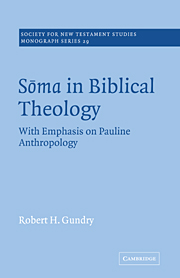Book contents
- Frontmatter
- Contents
- Acknowledgements
- Abbreviations
- PART I FOR AND AGAINST A HOLISTIC DEFINITION OF SŌMA
- PART II SŌMA IN THE FRAMEWORK OF ANTHROPOLOGICAL DUALITY
- PART III THE THEOLOGY OF SŌMA AS PHYSICAL BODY
- 13 The sōma in death and resurrection
- 14 Sōma and the being of man
- 15 Sōma, sin, and salvation
- 16 Sōma, individuality, and solidarity
- 17 Sōma and the Church as the Body of Christ
- Select bibliography
- Index of passages cited
- Index of authors
13 - The sōma in death and resurrection
Published online by Cambridge University Press: 14 January 2010
- Frontmatter
- Contents
- Acknowledgements
- Abbreviations
- PART I FOR AND AGAINST A HOLISTIC DEFINITION OF SŌMA
- PART II SŌMA IN THE FRAMEWORK OF ANTHROPOLOGICAL DUALITY
- PART III THE THEOLOGY OF SŌMA AS PHYSICAL BODY
- 13 The sōma in death and resurrection
- 14 Sōma and the being of man
- 15 Sōma, sin, and salvation
- 16 Sōma, individuality, and solidarity
- 17 Sōma and the Church as the Body of Christ
- Select bibliography
- Index of passages cited
- Index of authors
Summary
There is more than meets the eye in the implications of a consistent use of sōma for the physical body. It has theological repercussions in our interpretations of death and resurrection, the being of man, the nature and source of sin and salvation, individuality and corporateness, and the ecclesiastical Body of Christ. We take them in order.
The sōma in Death
With sōma as the physical body in distinction from the spirit, death consists neither in cessation of consciousness or of existence (as in un-Biblical materialism) nor in reduction of the substantiality or the functions of the whole man (as in a holistic interpretation of Biblical anthropology). Though these may accompany death, they do not constitute what death is in the first instance. Rather, death consists in the separation of the spirit and the body, which belong together. The body continues to exist for a short while, even though death has occurred, and then the body decays. The spirit continues to exist, and in addition bears consciousness.
The separation of spirit from body affects the spirit as well as the body. In the Biblical perspective, the physical body is just as essential to life which is life indeed as is the spirit. Barring the effects of sin (which touch the spirit, too), the body as such does not shackle the spirit. It provides the spirit with an organ of expression and action, just as the spirit provides the body with animation and direction.
- Type
- Chapter
- Information
- Soma in Biblical TheologyWith Emphasis on Pauline Anthropology, pp. 159 - 183Publisher: Cambridge University PressPrint publication year: 1976
- 2
- Cited by



